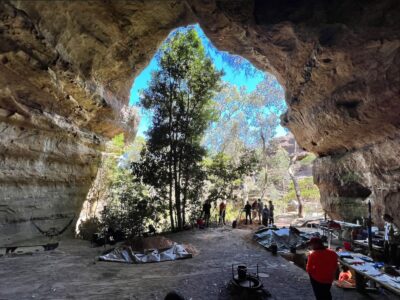Scientists still puzzle over how Earth emerged from its last ice age, an event that ushered in a warmer climate and the birth of human civilization. In the geological blink of an eye, ice sheets in the northern hemisphere began to collapse and warming spread quickly to the south. Most scientists say that the trigger, at least initially, was an orbital shift that caused more sunlight to fall across Earth’s northern half. But how did the south catch up so fast?

In a review paper published this week in the journal Science, a team of researchers look to a global shift in winds for the answer. They propose a chain of events that began with the melting of the large northern hemisphere ice sheets about 20,000 years ago. The melting ice sheets reconfigured the planet’s wind belts, pushing warm air and seawater south, and pulling carbon dioxide from the deep ocean into the atmosphere, allowing the planet to heat even further. Their hypothesis makes use of climate data preserved in cave formations, polar ice cores and deep-sea sediments to describe how Earth finally thawed out.
“This paper pulls together several recent studies to explain how warming triggered in the north moves to the south, ending an ice age,” said study co-author Bob Anderson, a geochemist at Columbia University’s Lamont-Doherty Earth Observatory. “Finally, we have a clear picture of the global teleconnections in Earth’s climate system that are active across many time scales. These same linkages that brought the earth out of the last ice age are active today, and they will almost certainly play a role in future climate change as well.”
Earth regularly goes into an ice age every 100,000 years or so, as its orientation toward the sun shifts in what are called Milankovitch cycles. At the peak of the last ice age, about 20,000 years ago, with New York City and large parts of Europe and Asia buried under thick sheets of ice, Earth’s orbit shifted. More summer sunlight began falling on the northern hemisphere, melting those massive ice sheets and sending icebergs and fresh water into the North Atlantic Ocean.
It may sound counterintuitive, but the paper says freshening of the North Atlantic triggered a series of cold spells in Greenland and northern Europe by shutting down the Gulf Stream current, which usually carries warm water north from the equator. Sea ice spread across the North Atlantic, bringing bitter cold winters to Europe and profoundly reshaping the planet’s wind belts.
With the North Atlantic in a deep freeze, the tropical trade winds shifted south, bringing dry spells across much of Asia and rain to normally arid regions of Brazil. The displaced winds moved not only rain further south, but hot air and warm seawater, heating up the southern hemisphere.
The southern hemisphere westerly winds also shifted south, bringing warm air and seawater to the mid-latitudes. By about 18,000 years ago, mountain glaciers in South America and New Zealand started to melt as the displaced winds blew warm air their way. By 16,000 years ago, the glaciers had beaten a spectacular retreat. This shift in westerly winds would also amplify the warming in both hemispheres by resetting the planet’s thermostat, as Anderson has proposed in an earlier study in Science. The displaced westerlies caused heavy mixing in the Southern Ocean around Antarctica, pumping dissolved carbon dioxide from the water into the air. Ice core records show that between 18,000 and 11,000 years ago atmospheric carbon dioxide levels rose from 185 parts per million to 265 parts per million. (Today levels are 393 parts per million, after a sustained rise during the industrial era.) The infusion of carbon dioxide came just as the planet’s orientation was shifting, and summer sunlight to the northern hemisphere was declining, at about 11,000 years ago. The boost in carbon dioxide may have prevented Earth from falling into another ice age, the scientists say.
“It’s the great global warming of all time,” said the study’s lead author, George Denton, a glaciologist at the University of Maine, and an adjunct scientist at Lamont. “We’re trying to answer the puzzle: why does the Earth, when it appears so firmly in the grip of an ice age, start to warm?”
Scientists have long suspected that carbon dioxide played a major role in the last ice age but have had trouble explaining the early warming in the southern hemisphere, where glaciers in Patagonia and New Zealand were melting before carbon dioxide levels rose significantly. Some scientists suggest that a change in ocean currents, triggered by the freshening of the North Atlantic, caused this early warming. But computer models using ocean circulation to explain the rapid warming in the south have been unable to recreate the large temperature jumps seen in the paleoclimate record. Now, with the evidence for shifting southern hemisphere westerlies, the rapid warming is readily explained.
Richard Alley, a glaciologist at Penn State University who was not involved in the study, called the hypothesis comprehensive and convincing. “This subject has long intrigued policy-makers, and although the issue in no way changes the very strong evidence that adding CO2 to the atmosphere has a warming effect, the inability of the scientific community to provide a complete explanation of the natural CO2 changes across ice-age cycles may have led some people to more broadly question climate science. Testing this hypothesis will be very interesting, to see whether it successfully “predicts” the observed timing of CO2 and temperature changes in the south.”


